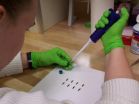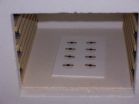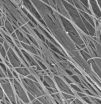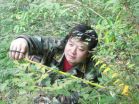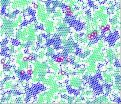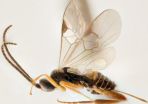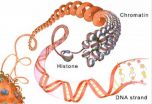(Press-News.org) Researchers from the National Institute of Standards and Technology (NIST) and the Food and Drug Administration (FDA) have demonstrated that they can make sensitive chemical analyses of minute samples of nanoparticles by, essentially, roasting them on top of a quartz crystal. The NIST-developed technique, "microscale thermogravimetric analysis," holds promise for studying nanomaterials in biology and the environment, where sample sizes often are quite small and larger-scale analysis won't work.*
Chemical analysis of nanoparticles is a challenging task, and not just because they're small. They're also complicated. They can become coated with other materials in their environment, and the question becomes, what materials? Or they might have been engineered with a coating, perhaps to provide anchor points for drug molecules, and then the question can be, how complete is the coating? In nanoelectronics, the question may be, how pure is the sample and just what are the impurities?
Researchers have an alphabetic array of tools for this, including scanning, transmission or atomic force microscopy (SEM/TEM/AFM); dynamic light scattering (DLS); nuclear magnetic resonance (NMR); and sundry spectrometry techniques, but they all have a variety of limitations, including complex sample preparation or the difficulty of analyzing enough particles to get a statistically significant result.
On the other hand, one technique, thermogravimetric analysis (TGA) is quite straight-forward. The sample is heated and monitored for changes in mass as the temperature increases. Sudden changes in mass correlate with the energies needed to decompose, oxidize, dehydrate or otherwise chemically change components in the sample. If you have some idea of what you start with, TGA can tell you much more, but it requires pretty substantial sample sizes.
NIST's technique is essentially the same except that a small piezoelectric quartz crystal is substituted for the mass scale. A tiny amount of a nanomaterial sample deposited on the crystal dampens the crystal's resonant frequency, and as the sample grows lighter, the frequency shifts. NIST researchers originally applied it to measure the purity of carbon nanotube samples.**
In this latest paper, the research team tested the utility of microTGA on typical nanomaterial analysis problems, including assessing the purity of carbon nanotubes, determining the amount of surface-bound ligands (i.e., molecular anchors) on gold nanoparticles, and testing for the presence of PEG, a polymer commonly used in medicine on silicon oxide nanoparticles.
"Our results are a pretty close match to other techniques," reports NIST analytical chemist Elisabeth Mansfield, "but using far less of a sample."
In fact, the team reports, microTGA gets results using samples a thousand times smaller than conventional techniques. It can work with one microgram of sample and detect mass changes of less than a nanogram. "That's important because you often don't have much of a sample.," Mansfield says," If you're pulling nanoparticles out of a water sample from the environment to measure how much exists in a real world sample, you're going to have very little to work with."
"In nanomedicine, the surface chemistry is oftentimes critically important to the performance of the nanomaterial," notes FDA chemist Katherine Tyner. "When working with real life samples, we may only have a very small sample amount. MicroTGA allows us to obtain information that we otherwise would not be able to get with conventional techniques."
INFORMATION:
*E. Mansfield , K.M. Tyner, C.M. Poling and J.L. Blacklock. Determination of nanoparticle tsurface coatings and nanoparticle purity using microscale thermogravimetric analysis. Anal. Chem., 2014, 86 (3), pp 1478-1484 DOI: 10.1021/ac402888v.
**See the November 2010 NIST story "Quartz Crystal Microbalances Enable New Microscale Analytic Technique" at http://www.nist.gov/public_affairs/tech-beat/tb20101124.cfm#qcm.
NIST microanalysis technique makes the most of small nanoparticle samples
2014-02-24
ELSE PRESS RELEASES FROM THIS DATE:
New biological scaffold offers promising foundation for engineered tissues
2014-02-24
Our cells don't live in a vacuum. They are surrounded by a complex, nurturing matrix that is essential for many biological functions, including growth and healing.
In all multicellular organisms, including people, cells make their own extracellular matrix. But in the lab, scientists attempting to grow tissue must provide a scaffold for cells to latch onto as they grow and proliferate. This engineered tissue has potential to repair or replace virtually any part of our bodies.
Typically, researchers construct scaffolds from synthetic materials or natural animal or human ...
Is previous hypoglycemia a risk factor for future hypoglycemic episodes?
2014-02-24
New Rochelle, NY, February 24, 2014—The automatic "threshold suspend" (TS) feature of an insulin pump helps prevent life-threatening hypoglycemic events when the device's sensor detects blood glucose concentrations below the preset threshold. However, in individuals with type 1 diabetes who have had previous episodes of hypoglycemia the TS feature may be less effective at preventing subsequent events, according to important new results from the ASPIRE study published in Diabetes Technology & Therapeutics (DTT), a peer-reviewed journal from Mary Ann Liebert, Inc., publishers. ...
Vitamin water: Measuring essential nutrients in the ocean
2014-02-24
The phrase, 'Eat your vitamins,' applies to marine animals just like humans. Many vitamins, including B-12, are elusive in the ocean environment.
University of Washington researchers used new tools to measure and track B-12 vitamins in the ocean. Once believed to be manufactured only by marine bacteria, the new results show that a whole different class of organism, archaea, can supply this essential vitamin. The results were presented Feb. 24 at the Ocean Sciences meeting in Honolulu.
"The dominant paradigm has been bacteria are out there, making B-12, but it turns ...
OU researcher and team discover disease-causing bacteria in dental plaque preserved for 1,000 years
2014-02-24
When a University of Oklahoma researcher and an international team of experts analyzed the dental calculus or plaque from teeth preserved for 1,000 years, the results revealed human health and dietary information never seen before. The team discovered disease-causing bacteria in a German Medieval population, which is the same or very similar to inflammatory disease-causing bacteria in humans today—unlikely scientific results given modern hygiene and dental health practices.
Christina Warinner, research associate in the Molecular Anthropologies Laboratories, OU College ...
Gauging what it takes to heal a disaster-ravaged forest
2014-02-24
Recovering from natural disasters usually means rebuilding infrastructure and reassembling human lives. Yet ecologically sensitive areas need to heal, too, and scientists are pioneering new methods to assess nature's recovery and guide human intervention.
The epicenter of China's devastating Wenchuan earthquake in 2008 was in the Wolong Nature Reserve, a globally important valuable biodiversity hotspot and home to the beloved and endangered giant pandas. Not only did the quake devastate villages and roads, but the earth split open and swallowed sections of the forests ...
Penn researchers 'design for failure' with model material
2014-02-24
When deciding what materials to use in building something, determining how those materials respond to stress and strain is often the first task. A material's macroscopic, or bulk, properties in this area — whether it can spring back into shape, for example — is generally the product of what is happening on a microscopic scale. When stress causes a material's constituent molecules to rearrange in a way such that they can't go back to their original positions, it is known as "plastic deformation."
Researchers at the University of Pennsylvania have devised a method to study ...
Parents' attitudes about helping their grown children affect their mental health
2014-02-24
Older parents frequently give help to their middle-aged offspring, and their perceptions about giving this help may affect their mental health, according to a team of researchers.
"We usually view the elderly as needy, but our research shows that parents ages 60 and over are giving help to their children, and this support is often associated with lower rates of depression among the older adults," said Lauren Bangerter, Ph.D. student in human development and family studies, Penn State.
The team -- which included researchers at Penn State, the University of Texas ...
Specialized cognitive therapy improves blood sugar control in depressed diabetes patients
2014-02-24
Although maintaining good blood sugar control is crucial for avoiding complications of diabetes, it has been estimated that only about half of patients are successful in meeting target blood glucose levels. The prevalence of depression among diabetes patients – up to twice as high as in the general population – can interfere with patients' ability to manage their diabetes. Now a group of Massachusetts General Hospital (MGH) investigators report that a program of cognitive behavioral therapy that addresses both mood and diabetes self-care led to improved blood sugar control ...
Almost 200 new species of parasitoid wasps named after local parataxonomists in Costa Rica
2014-02-24
An inventory of wild-caught caterpillars, its food plants and parasitoids, has been going on for more than 34 years in Area de Conservación Guanacaste (ACG), a protected area of approximately 1200 km2 in northwestern Costa Rica. As a result, more than 10,000 species of moths and butterflies are estimated to live in ACG. Their caterpillars are in turn attacked by many parasitoid wasps, also numbering thousands of species. However, most of those wasps have never been described and remain unknown.
For the past few years researchers from Canada, Costa Rica and the United ...
New technology detect cellular memory
2014-02-24
Cells in our body are constantly dividing to maintain our body functions. At each division, our DNA code and a whole machinery of supporting components has to be faithfully duplicated to maintain the cell's memory of its own identity. Researchers at BRIC, University of Copenhagen, have developed a new technology that has revealed the dynamic events of this duplication process and the secrets of cellular memory. The results are published in Nature Cell Biology.
In 2009, two women at BRIC, University of Copenhagen joined forces to develop a new technology that could elucidate ...
